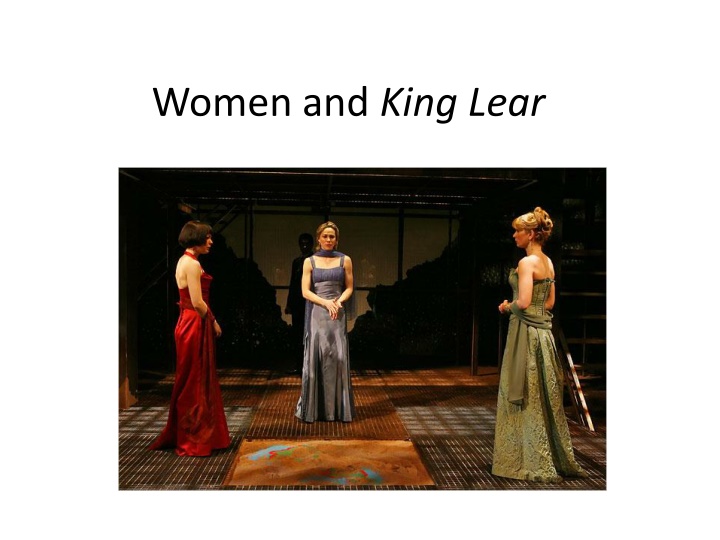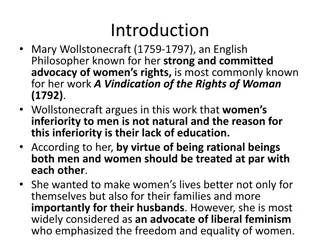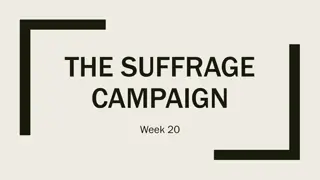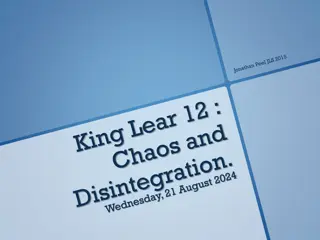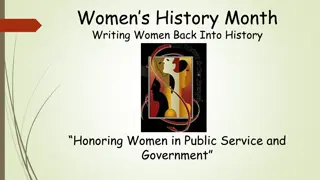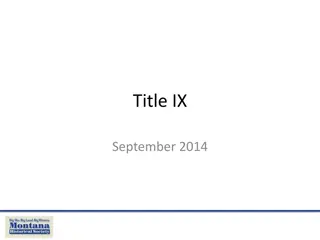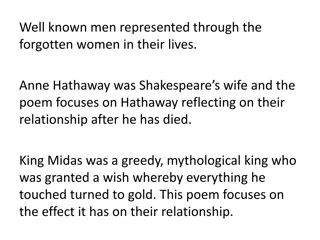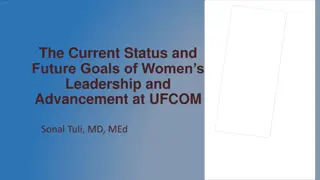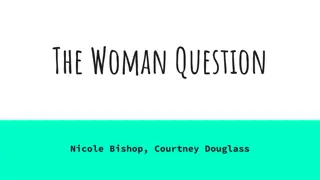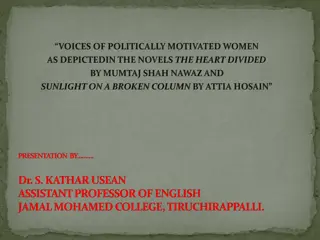Women and King Lear
Early feminist criticism of King Lear showcases contrasting views, from portraying Shakespeare as a feminist writer to highlighting the play's misogynistic undertones. Scholars like Marilyn French, Linda Bamber, Kathleen McLuskie, and Copplia Kahn offer unique insights on gender dynamics, family relationships, and the absence of maternal figures within the tragedy. Through historical analysis and psychoanalytic interpretations, these scholars delve into the complex portrayal of women and female resistance in Shakespeare's iconic play.
Download Presentation

Please find below an Image/Link to download the presentation.
The content on the website is provided AS IS for your information and personal use only. It may not be sold, licensed, or shared on other websites without obtaining consent from the author.If you encounter any issues during the download, it is possible that the publisher has removed the file from their server.
You are allowed to download the files provided on this website for personal or commercial use, subject to the condition that they are used lawfully. All files are the property of their respective owners.
The content on the website is provided AS IS for your information and personal use only. It may not be sold, licensed, or shared on other websites without obtaining consent from the author.
E N D
Presentation Transcript
Women and King Lear http://graphics8.nytimes.com/images/2007/03/08/theater/Lear3650.jpg
Feminist criticism http://girlempowered.files.wordpress.com/2013/02/feminism.gif - A general overview of some of the feminist perspectives on the play. - Use to guide your reading - Be purposeful/ critical
Marilyn French/ Linda Bamber Early feminist criticism of play suggest that Shakespeare is a feminist writer, sympathetic to the difficulties of the female he represents. Critics often compare women in the play with Puritan goodwife/ companion/ stereotype of the time, much debated in Renaissance handbooks, to support their points. However, doesn t take into account historical circumstance, only the values ascribed to men and women. This view presents feminism as a set of social attitudes rather than a project for fundamental social change. http://lima.osu.edu/history/historyclub/raphael.jpg
Kathleen McLuskie The Patriarchal Bard: feminist criticism and Shakespeare McLuskie sees the play as fundamentally misogynistic and also, a paradigm for the sexual politics of its genre (tragedy) and history (Shakespeare s time). Tragedy is misogynistic as although it claims to talk about the existence of a permanent, universal and unchanging condition, the protagonist is always male/ with male concerns and plots. Adding to this, Shakespeare aligns anarchy and sexual insubordination via Goneril and Regan. In chronicle play King Leir , sisters villainy is a plot device; their mocking pleasure at C s downfall a comic act and their evil is an exciting plot twist on Lear s life. http://www.anorak.co.uk/wp-content/gallery/misogyny-adverts/misogyny-23.jpg
Kathleen McLuskie The Patriarchal Bard: feminist criticism and Shakespeare In King Lear , all female resistance is defined by gender, sexuality and position in the family; family relations are fixed and any move against them is portrayed as a destructive move against the rightful order. For example: into her womb convey sterility Lear, 1.4 whores do churches build Fool, 3.1 women will all turn monsters servant, 3.7 humanity must perforce prey on itself,/ like monsters of the deep Albany, 4.2 http://static.guim.co.uk/sys-images/Guardian/Pix/pictures/2012/9/12/1347406526553/King-Lear-at-the-Almeida-010.jpg
Copplia Kahn, The Absent Mother in King Lear Misogyny is instrumental and instructive; charts Lear s progress from misogynist rejection of womanly values to a final acceptance of his more womanly qualities. It s an exploration of male anxiety in a historical account of the way feelings are apparently feminine. Psychoanalytical reading of play which suggests Lear s desire to be mothered by Cordelia. http://tarbeyah.files.wordpress.com/2012/01/mother-and-child2.jpg
Copplia Kahn, The Absent Mother in King Lear O! How this mother swells upward toward my heart/ Hysterico passion! Down, thou climbing sorrow/ Thy element s below! (2.4, 56-8) Hysteria characterized as feminine disease of the hyster, the womb. In Shakespeare s time, hysteria also called the mother vivid metaphor to describe the woman in society; destined for childbirth, but physically weaker than man. Womb is a sign of weakness; remedy is regular sexual intercourse/ husband. Signifies her weakness for the flesh over mind/ spirit. https://encrypted-tbn1.gstatic.com/images?q=tbn:ANd9GcTQGIWhbanqBwNzM2QRSkAeTsiuCvsd6pFfKw_74C7D8BjgBq_Q
Copplia Kahn, The Absent Mother in King Lear First scene about male anxiety; real purpose is about giving away his youngest daughter; variation of wedding scene; bond between father and daughter. Perhaps Lear is deliberately manipulating giving away of Cordelia; incestuous purpose. The surrender of her also awakens a deeper emotional need in Lear; need for the daughter/ mother Lear as a child: wants absolute power over those closest to him and to be absolutely dependent on them. Pre-Oedipal experience/ desire. As man, father and ruler, habitual needs for love have been repressed; he wants to crawl like a baby towards death. He needs his nursery Goneril and Regan don t provide this; hence re-enactment of a childish rage about the absence of a mother figure. http://www.rsc.org.uk/images/content/Photo_Galleries-2009_earlier/kle_0704_gallery_02.jpg
Introductory activity for Act 4, scene 2 To thee a woman s services are due,/ A fool usurps my bed. (Goneril to Edmund) Some critics find the sudden revelation that both Goneril and Regan love Edmund a little far-fetched. If you were directing a play how would you deal with this love triangle? What advice would you give the actors? (AO3) http://farm8.staticflickr.com/7122/6966298654_71c6fccea2_z.jpg
Close reading of Act 4, scene 2 Focusing on presentation of Goneril The role of Albany Edmund s motivations Relationship between the sisters Critical links to feminist criticism
Activity women in the play Tigers, not daughters This is a play full of images which present women as monstrous or inhuman. Collect examples from the play making a careful note of who is speaking and the context. Would you agree that this play reflects a patriarchal world view and seems terrified by women and what they might represent? https://encrypted-tbn0.gstatic.com/images?q=tbn:ANd9GcQXPmcKUpbFODLmPLl7_6XfWEAKBkdsaAn_vEGXZ0FBQXxerjkR1g
